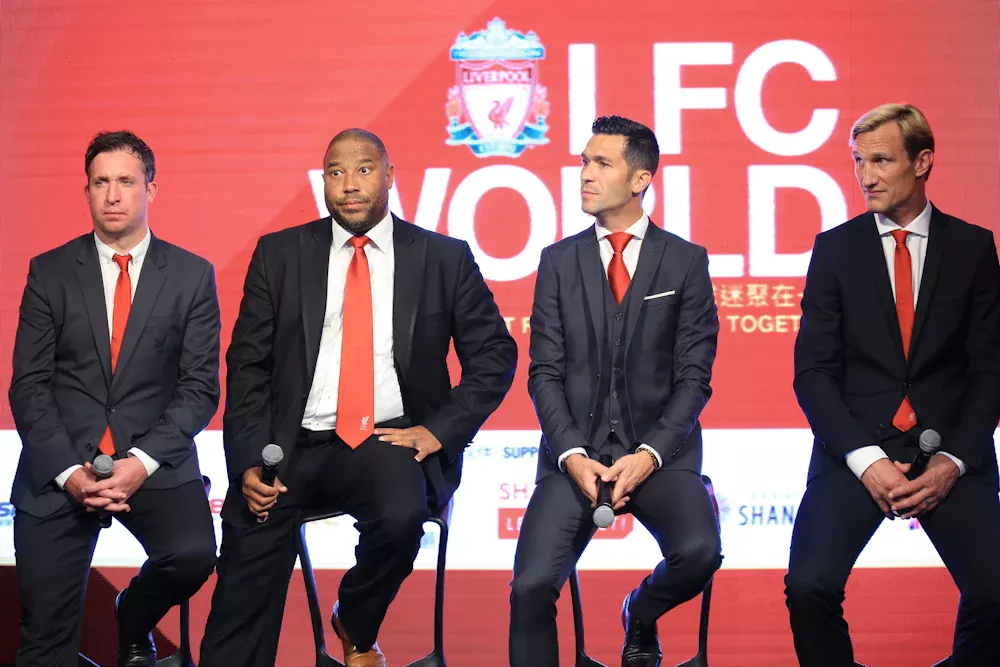John Barnes - Liverpool's absolute hero
Liverpool's football dominance in the 70s and 80s is very well-documented and is the backbone of that club's legacy in the game. The Reds were by far the definitive English football club during those years and had a lot of great players who defined that institution in that period, with the likes of Kenny Dalglish, Ian Rush, Kevin Keegan, Graeme Souness, and a few more being the most prominent.
John Barnes, second from the left, here together with Robbie Fowler, Luis Garcia and Sami Hyypiä at an LFC oldies meeting
Time at Watford
John Barnes quickly made a name for himself at youth level and got people noticing his talents, which is why Watford managed to sign him in the summer of 1981. There is also the fun anecdote of him being signed from Sudbury Court for Watford for a set of kits, which says a lot about the football market back then.It's also worth pointing out that this was the era when Sir Elton John, a long-time Watford fan, bought the club and invested in the institution. This is why Barnes started in the Second Division back in 1981 and quickly rose through the ranks as Watford were getting promoted to the top tier of English football, with him scoring an amazing total of 14 goals in 44 games across all competitions, which is quite good for an 18-year-old in his first professional season.
Once the club got promoted to the First Division in 1982, Barnes played there until 1987. The interesting part is that Barnes scored at least 13 goals every season in the top tier of English football with Watford, helping the team greatly and quickly becoming one of the most promising and entertaining players in the league.
Barnes had a good combination of a knack for scoring goals and also a lot of great movements, coupled with physical strength, which made him an extremely capable attacking player back in the 80s. So, it was fairly predictable that he was eventually going to sign for a bigger club and the summer of 1987 was the moment that took place.
However, there is also something worth pointing out: Alex Ferguson, manager of Manchester United, wanted to sign John Barnes at the moment but decided to give his left winger at the time, Jesper Olsen, another opportunity. This is something that the Scottish manager, based on his statements, would end up regretting, especially considering where Barnes ended up.
At Liverpool
Barnes' signing for Liverpool at the time had some interesting reactions. While his performances with Watford were of an extremely high level, he had struggled greatly in the England setup, which is why a lot of people began to have questions about him performing with better players. It is a common situation in football: the big fish on a small pond analogy, if you will.However, manager Kenny Dalglish, a Liverpool legend in his own right, already had a game plan in mind with the signing of John Barnes in the summer of 1987. Attackers Peter Beardsley and John Aldridge formed a great offensive triumvirate with Barnes, scoring 64 goals together in their first season as a unit and winning the First Division.
Most people agree that Barnes' first seasons with Liverpool were his peak as a player in terms of achievements, form, and even the cultural impact he had. He had become one of the most popular players in the First Division and was playing for the best club in the country at the moment, which made him lose the chance of playing in the European Cup in his prime due to the Heysel Disaster all the more disappointing.
While the 80s were a phenomenal period for Barnes and Liverpool, the 90s were a completely different story. Coupled with the rise of Manchester United, Liverpool were also struggling to revamp the side and the decline in quality was definitely felt, which is something that took the club decades to recover from.
Barnes still performed but age and the inconsistency of the squad led to him having a steady decline over the years. Perhaps the most interesting aspect of Barnes' career in the 90s was how he adapted to other positions: as he was losing opportunities to play as a left winger, his favorite position, he began to play more centrally as he grew older, which allowed him to stay in football for a longer period of time.
Eventually, in the summer of 1997, John Barnes left Liverpool as a free agent. He had played there for an entire decade and had become a symbol of the club's last great period of dominance, so is safe to say that his exit represented the end of a glorious chapter in that institution's history.
Life after Liverpool
Barnes signed for Newcastle for the 1997/98 season and played regularly, even if the season wasn't very positive for the Magpies. The second season, however, was a lot more troublesome because he had a lot of issues with Dutch manager Ruud Gullit, who didn't seem to fancy him, although the reasons for the dislike between one another has been discussed even to this very day.Things were so bad between those two that Barnes was sold to Charlton Athletic in February of 1999 and stayed there for the remaining of the season, playing mostly as a sub. He was originally going to sign for Celtic in Scotland but didn't play.
John Barnes was one of the best English players of the 80s and his legacy with Liverpool is highly underrated. And deserves all the recognition he can get.
